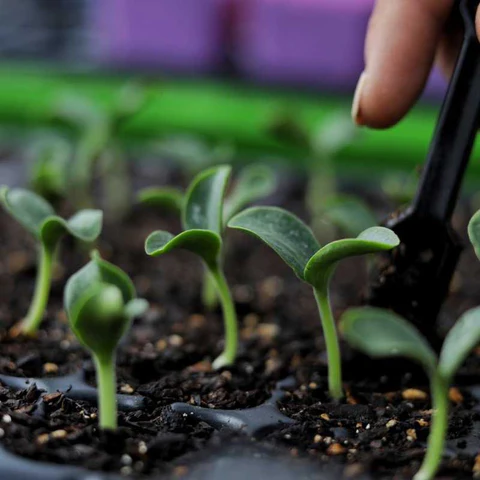The Top 10 Tips for Successful Seed Starting

Introduction
Seed starting is a crucial step in the journey of every gardener and horticulturist. Whether you're a seasoned green thumb or a novice gardener, your seedlings' growth success depends on various factors, from temperature and growing media to light and disease control. This introductory guide will explore the top 10 tips for seed-starting success. These tips cover essential aspects such as air temperature, growing media options, airflow, watering, humidity, light, nutrients, transplanting, potting up, disease control, and choosing between seeds and cuttings. Following these guidelines ensures your seedlings get the best start possible, leading to healthy, robust plants in your garden.
Optimal Air Temperature
One of the first considerations for successful seed starting is maintaining the correct air temperature. Different plants have different temperature requirements, so knowing the ideal range for your specific seeds is essential. However, as a general rule of thumb, most seeds germinate best at temperatures between 65°F and 75°F (18°C to 24°C).
- Use a thermometer to monitor temperature: Invest in a good-quality thermometer to closely monitor the temperature in your seed-starting area. This will help you make necessary adjustments to maintain the ideal conditions.
- Heat mats and thermostats: To ensure a consistent temperature, use heat mats with thermostatic controls. These mats provide gentle bottom heat to the seed trays and can be adjusted to the desired temperature range.

Heat Mat Controller
Choosing the Right Growing Media
Selecting the appropriate growing media is crucial for seed-starting success. A well-balanced, sterile growing medium will provide the necessary support and nutrients for germinating seeds. Consider the following options:
- Seed starting mix: Seed starting mixes are specially formulated for seed germination. They are lightweight, well-draining, and free from disease pathogens. Avoid using regular garden soil, as it may contain weed seeds and diseases.
- Homemade mix: You can also create your own seed starting mix by combining ingredients like peat moss, perlite, and vermiculite. This allows you to customize the mix to suit the needs of specific plant varieties.
Ensure Adequate Airflow
Proper airflow is essential for preventing fungal diseases and promoting healthy seedling growth. Stagnant air can lead to mould and damping-off issues, harming your seedlings. To maintain good airflow:
- Use a fan: Place a small, oscillating fan near your seedlings. This will help improve air circulation and reduce humidity around the plants.
- Avoid overcrowding: Plant your seeds at the recommended spacing to prevent overcrowding, which can lead to poor airflow between seedlings.

Modern Air Conditioner In Grown Greenery On Background, Top View With Warning Sign For Safety.
Watering Wisely
Overwatering is a common mistake when starting seeds. Too much moisture can lead to damping-off disease, root rot, and poor germination rates. To water your seedlings effectively:
- Bottom watering: Water your seedlings from below by placing the seed tray in a shallow container filled with water. Allow the growing medium to absorb moisture through the drainage holes. This prevents water from splashing onto the leaves and reduces the risk of fungal diseases.
- Use a fine mist sprayer: When your seedlings are very young, use a fine mist sprayer to keep the growing medium's surface consistently moist. Avoid soaking the soil.
- Monitor moisture levels: Stick your finger into the growing medium to check for moisture. Water only when the top inch (2.5 cm) feels dry to the touch.
Control Humidity
Maintaining the proper humidity levels in your seed-starting area is crucial for germination and early growth. Here's how to control humidity effectively:
- Use a humidity dome: Covering your seed trays with a clear plastic humidity dome or plastic wrap can help create a controlled environment with higher humidity. Remove the dome once the seedlings emerge to prevent excessive moisture buildup.
- Humidity tray: Place a tray filled with water near your seedlings. As the water evaporates, it will increase the humidity around the plants.

5X5Humidity Dome
Provide Adequate Light
Proper lighting is essential for vigorous, healthy seedlings. While some seeds require darkness for germination, most seedlings need ample light to grow well. Here's how to ensure adequate light for your seedlings:
- Natural light: Place your seed trays in a sunny south-facing windowsill or under grow lights that mimic natural sunlight.
- Grow lights: Invest in high-quality fluorescent or LED grow lights if you don't have access to sufficient natural sunlight. Position the lights close to the seedlings and adjust their height as the plants grow to maintain the right intensity.
- Photoperiod: Be mindful of the photoperiod (day length) requirements of your specific plants. Some seeds require specific day lengths to trigger germination and growth.

Seedlings Under Grow Lights
Provide Nutrients
While seedlings initially rely on the nutrients stored in the seed, they will eventually need additional nourishment. As they grow, transplant them into larger containers with a balanced potting mix that includes essential nutrients. Additionally:
- Start fertilization when true leaves appear: Once your seedlings have developed their first true leaves (distinct from the cotyledons), begin feeding them with a diluted, balanced liquid fertilizer. Follow the manufacturer's recommendations for application rates.
- Avoid over-fertilization: Be cautious not to over-fertilize, as this can lead to nutrient imbalances and damage to the seedlings. Always follow recommended dosage instructions.
Transplanting at the Right Time
Transplanting is a critical step in the seed-starting process. It involves moving seedlings from their original containers (such as seed trays) into larger pots or directly into the garden. Here's how to do it successfully:
- Please wait for the right stage: Transplant seedlings when they have developed at least two sets of true leaves. This stage ensures they have a robust root system to support growth in their new home.
- Handle seedlings gently: When transplanting, handle seedlings carefully to avoid damaging the roots or stems. Use a spoon or transplanting tool to lift the seedlings out of their containers.
- Maintain spacing: Ensure adequate spacing between transplanted seedlings to prevent crowding, which can lead to competition for resources and poor growth.

Seedling Cube
Potting Up Gradually
As your seedlings grow, they will need more space and nutrients. Potting up involves moving them into larger containers to accommodate their increasing size. Follow these tips for successful potting up:
- Choose the right container size: Select containers one size larger than the current ones to allow for root growth. Ensure the containers have drainage holes to prevent waterlogged soil.
- Use a high-quality potting mix: Transition your seedlings to a well-balanced potting mix that provides adequate nutrients and drainage.
- Water thoroughly after potting up: After transplanting into larger containers, water the seedlings well to help them settle into their new homes.

Pots / Potting Up
Disease Control
Preventing and managing diseases is essential for seed-starting success. Here are some strategies to keep your seedlings disease-free:
- Maintain cleanliness: Keep your seed starting area clean and sanitized. Sterilize your containers and equipment before use to prevent the introduction of pathogens.
- Proper ventilation: As mentioned earlier, good airflow helps reduce humidity and minimizes the risk of fungal diseases.
- Isolate affected seedlings: If you notice any seedlings showing signs of disease, promptly remove and isolate them to prevent the spread of the infection.
- Use disease-resistant varieties: Whenever possible, choose seed varieties known to be resistant to common diseases in your region.
Seeds vs Cuttings: Which is Better?
In the plant propagation world, seeds and cuttings have advantages and disadvantages. Here's a brief comparison to help you decide which method suits your needs:
Seeds:
- Wider variety: Seeds offer access to a broader range of plant varieties and species.
- Genetic diversity: Seeds result in genetically diverse plants, which can benefit plant breeding and adaptation.
- Cost-effective: Seeds are generally more affordable than purchasing established plants or cuttings.
- Longer lead time: It takes longer for plants grown from seeds to reach maturity than cuttings.
- Susceptible to variability: Genetic variability can lead to variations in plant characteristics.
Cuttings:
- Clonal propagation: Cuttings produce genetically identical plants to the parent, preserving specific traits and characteristics.
- Faster growth: Cuttings typically establish and grow faster than plants started from seeds.
- Consistency: Cuttings provide consistency in plant characteristics, which is vital for commercial growers.
- Limited diversity: Cuttings restrict you to a narrower range of plant varieties compared to seeds.
- Potentially higher cost: Purchasing established cuttings can be more expensive than buying seeds.
Conclusion
Successful seed starting is a rewarding endeavour that requires attention to detail and adherence to best practices. By considering factors such as air temperature, growing media, airflow, watering, humidity, light, nutrients, transplanting, potting up, disease control, and choosing between seeds and cuttings, you can give your seedlings the best chance for robust growth. Remember that patience and diligence are key when nurturing your young plants. With the right care and these top 10 tips, you'll be well on your way to a bountiful and thriving garden. Happy gardening!

